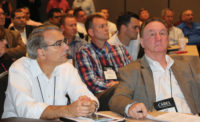Supermarkets and their needs will always be one of the front-and-center elements of the HVACR industry. These high-profile businesses operate long hours, use large amounts of energy, and have tens of thousands of dollars in perishable product that needs refrigeration 24/7. Trends in supermarkets can often provide insights into changes to come for the rest of the commercial refrigeration world, and — as is the case industry-wide — refrigerants are on the minds of many in the supermarket sector.
At Hillphoenix Refrigeration Systems, Derek Gosselin, product manager, said that as the U.S. Environmental Protection Agency (EPA) continues to push further legislation to phase out high-GWP (global-warming potential) refrigerants and the industry moves towards lower-GWP or natural refrigerant options, consideration of future retrofit cost avoidance has become an important trend, as has the additional cost per pound of newer refrigerant options.
“The system’s total refrigerant charge and leak rate are also important in the startup and maintenance of systems,” Gosselin said.
Rusty Walker, senior corporate trainer, Hillphoenix, said most technicians aren’t ready for the alternative refrigeration changes that are on the horizon, but Hillphoenix is working and training hard to change that.
Many of the contractors Walker trains on Hillphoenix’s Second Nature® CO2 booster, cascade, or secondary systems — both at store sites and at the company’s Learning Center in Conyers, Georgia — are surprised by how simple it is to learn the alternative refrigeration system.
He noted that, although they have different components and pressures, CO2 systems operate on the same fundamentals as the traditional refrigeration systems with which contractors and technicians are already very familiar.
“In a trained technician’s hands, a CO2 refrigeration system is just as safe and simple to operate and maintain as a traditional refrigeration system,” Walker said. “Thousands of technicians have gone through our CO2 training — more than 320 since the beginning of this year. Of course, we’d like it if all of them went on to work on Hillphoenix systems, but, our leadership role in getting the entire industry ready for the next phase of alternative refrigeration systems is a top priority.”
For contractors who deal with the hot side of supermarkets, Hillphoenix has introduced a convection-assist hot case to help satisfy consumers’ increasing appetites for meals to go.
Nathan Perkins, manager of product engineering, Hillphoenix Specialty Products, explained that many end users in the supermarket industry are accustomed to self-service hot cases equipped with bottom heating elements that provide heat to the product through touch or conduction. In such cases, product temperatures are completely dependent upon the long-wave radiant heat that is generated from the heating pads in the case with minimal heat in the air around the product. When heated air remains relatively motionless around the product, it tends to receive more heat to the portion of the packaging that is in contact with the shelf. With the move to greener packaging, such as paper and film pouches, it has become more difficult to achieve these results from conduction heating.
“One answer to this problem is the implementation of convection heat,” Perkins said. “Convection heat is applied by the use of forced-air heat circulating heat circulating evenly around the product. By utilizing this method in the PFH Convection Assist hot case, Hillphoenix Specialty Products helps customers and their merchandising teams prevent cold or hot spots on the food. The PFH extends product shelf life and ensures compliant temperatures for up to four hours on all products that enter the unit at 200°F or above.”
CARBON DIOXIDE SYSTEMS EVOLVING
Hussmann Corp.’s Purity offering is a multiple compressor system that uses R-744 (CO2) exclusively. Purity is designed to operate efficiently in low-, medium-, and high-temperature applications and can be used in combination with all three. According to Hussmann, the Purity system is optimized for an operating range of 15-225 ton and is highly adaptable for use in most climatic conditions. In addition, each Purity system is designed with precise line sizing to limit pressure losses, increase efficiency, and enhance performance.
According to Dave Tomicki, technical sales leader, refrigeration systems, Hussmann Corp., the Purity system can replace a standard DX supermarket refrigeration system. He noted that, although the technology is just being introduced into the U.S. market, Hussmann, through its LMP subsidiary, has 15 grocery stores and a number of cold storage facilities and distribution warehouses operating in North America.
“We have more than five years of run time on these systems already, and their performance and reliability is outstanding,” he said.
As with any new technology, Hussmann is working to educate its customers about transcritical CO2 systems.
“Any technology has its pros and cons,” Tomicki said. “Those pros and cons will become evident over time; we prefer to keep customers informed upfront.”
For example, Tomicki noted that a grocery store using a transcritical CO2 system would have to ensure it had a supply of CO2 on-site, or readily accessible as well as replacements for the system’s major components.
“If you go into a typical supply house, you probably won’t find a lot of the CO2 components, such as compressors and specialty valves,” he said. “So, the facility must be prepared to keep the system operating not only on the service side but on the equipment side, as well. Ice cream has no patience.”
Tomicki added that all the recent changes in the refrigeration world have made refrigeration design choices complicated.
“Customers are trying to be educated about refrigeration systems, but it’s changing so rapidly and there are so many pending regulations involved that you really have to live in that world to understand your options,” he said. “The EPA has phased out refrigerants before, but now the agency’s looking to phase out specific uses of refrigerants for specific applications. It can be very difficult to follow, and that’s why Hussmann is constantly striving to educate our customers so they can make informed decisions. It’s also why Hussmann aligned with LMP, so that we offer choices to our customers that best fit their needs and business objectives.”
DISPLAYING, SWAGING, AND CONVERTING
To help supermarket operators attractively present their wares, Master-Bilt has introduced a full line of glass door merchandisers with its next-generation BMG/BLG Plus and Fusion Plus models.
The new bottom-mounted medium-temperature (BMG) and low-temperature (BLG) glass door merchandisers feature full-height glass doors with four adjustable cantilever shelves per door to optimize product visibility and double-strip LED lighting. Master-Bilt’s electronic control system is designed to provide reliable, continuous temperature performance. The BMG/BLG Plus models also increase pack-out and product visibility with
23 ½-inch-deep shelving. They are available in six cooler sizes with swing and slide door options, and four freezer sizes with swing doors. They can also be configured in all-white or all-black interior/exterior color options.
The Fusion Plus models feature an overhead illuminated graphic panel for attention-grabbing signage. All MasterBilt glass door merchandisers are Energy Star-qualified.
Mastercool Inc.’s 71700 hydraulic flaring and swaging tool is a hand-held hydraulic press designed to accurately and consistently flare and swage copper tubing. According to Mastercool reps, the unit is designed to work with small copper as it forms the expansion or flare and is well-suited for supermarket refrigeration work. To use, the user simply secures the die and adapter into the fixture and pumps the handle a few times.
The hydraulic flaring and swaging tool is an extension of Mastercool’s patented Hydra-Swage design series. The 71700 kit comes in a custom-molded carrying case that includes dies and adapters for flaring and swaging copper tubing sizes ¼-, 5/16-, 3/8-, ½-, 5/8-, ¾-, and 7/8-inch sizes.
Sporlan has released its next-generation CDS conversion kits designed to convert SORIT evaporator pressure regulators on refrigeration equipment into stepper motor-driven CDS valves. According to Sporlan, nearly all A8 and SPORT pressure regulators can now be converted into Sporlan stepper motor valves using only one of three kits in a retrofit that takes about 30 minutes.
Sporlan CDS valves are electronically operated step motor evaporator pressure-regulating valves. Synchronized signals to the motor provide discrete angular movements of the rotor, which translate into linear positioning of the valve piston through a lead screw attached to a series of gears. Valve pistons and ports have an engineered profile and can be interfaced easily with microprocessor-based controllers.
“As supermarket refrigeration equipment moves toward greater electronic control, Sporlan’s new conversion kit enables the conversion of a wider range of older mechanical valves to electronic valve control,” said Dustin Searcy, product manager, electric valves, Sporlan Division, Parker Hannifin Corp. “In fact, tens of thousands of these conversions have been completed in the past 10 years, improving performance and reducing costs.”
According to Searcy, valves that qualify for conversion include refrigerating specialties mechanical pressure regulators such as the A8A, A81, A82, and SPORT valves. Conversion kits can be driven directly by Sporlan’s Micro Thermo control systems or other common third-party enterprise control systems.
ENERGY AND THE ENVIRONMENT
At KeepRite Refrigeration, John Murray, executive vice president and national sales manager, said energy and the environment are the biggest drivers in the refrigeration equipment industry.
“In the future, we’re expecting the DOE to raise the bar on efficiency levels in refrigeration equipment — much like higher SEER ratings raised the bar for residential air conditioning equipment years ago,” Murray said. “Between the energy-efficiency regulations and the recent refrigerant regulation changes from the EPA, virtually everything we’re doing addresses both energy and the environment.”
That means the company is focusing on smaller compressorized systems distributed around a supermarket, less piping, and less refrigerant charge coupled with energy-saving technologies, such as digital compression and electronically commutated motors (ECMs).
KeepRite’s electronically commutated (EC) shafted motors offer EC technology in a North American retrofittable version. According to the company, the motors’ lightweight, modular design allows for unprecedented serviceability and retrofit opportunities, even in high-horsepower applications.
Vince Zolli, engineering manager, KeepRite, added that from a store layout standpoint, the move is toward compact designs.
“Rather than big racks that use large semi-hermetic compressors, we’re breaking that rack up into separate units,” Zolli said. “Then, we’re taking those smaller packages and using readily available equipment, such as scroll compressors, making the systems very compact and easy to service.”
KeepRite’s custom-designed Link and Link+ multi-compressor refrigeration systems have a compact design that fits through standard commercial door openings. In addition, Link units have a consolidated electrical layout designed to provide for significantly reduced electrical installation costs, and the systems’ multiple compressors can be tied into common suction groups.
As far as refrigerants, Zolli said KeepRite expects R-407A, -448, or -449 to become the refrigerant of choice in commercial refrigeration equipment.
“We shoot ourselves in the foot if we all flock to a refrigerant and it consumes more energy,” Zolli said. “You lose on the indirect environmental effect of more energy consumption. Our testing to date has revealed that some of the new blends offer greater efficiency and similar capacity, and there’s good potential there to have something work as well as or better than R-404A.”
In addition, Zolli noted that many low-GWP refrigerant blends also have good potential not only in new equipment, but also from a drop-in replacement standpoint.
“That’s huge because retrofits are going to be happening for many years to come,” he said.
Publication date: 9/7/2015
Want more HVAC industry news and information? Join The NEWS on Facebook, Twitter, and LinkedIn today!







Report Abusive Comment